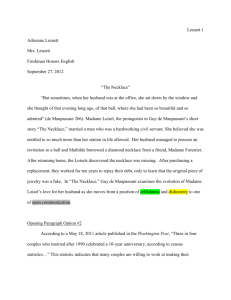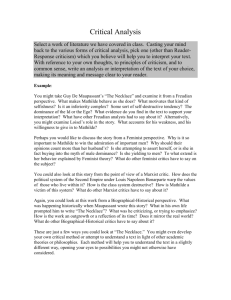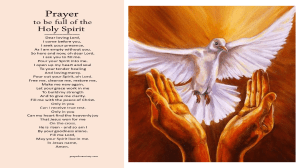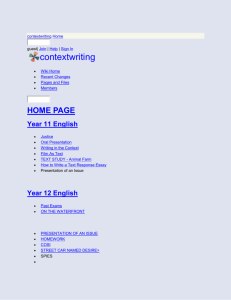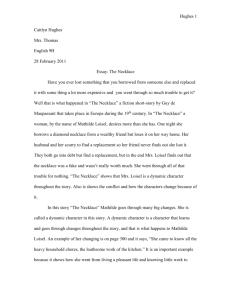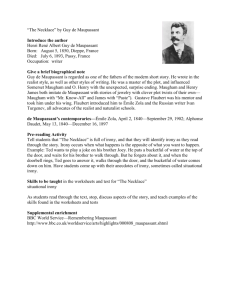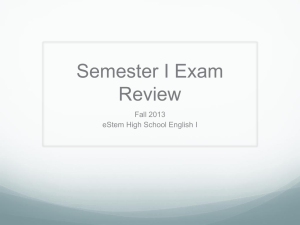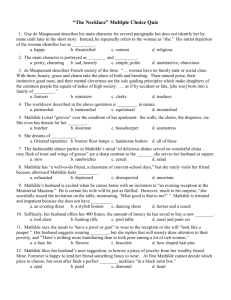“The Necklace” by Guy de Maupassant Vocabulary: Define and
advertisement
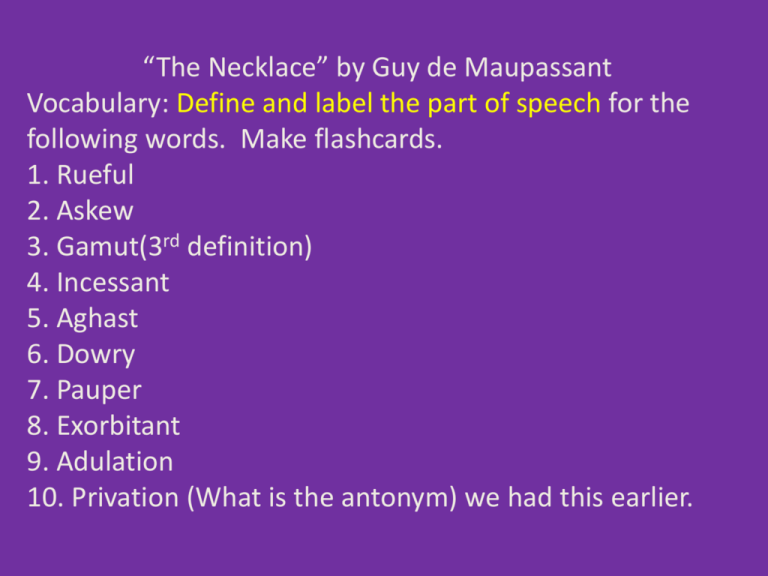
“The Necklace” by Guy de Maupassant Vocabulary: Define and label the part of speech for the following words. Make flashcards. 1. Rueful 2. Askew 3. Gamut(3rd definition) 4. Incessant 5. Aghast 6. Dowry 7. Pauper 8. Exorbitant 9. Adulation 10. Privation (What is the antonym) we had this earlier. “The Necklace” by Guy de Maupassant 1. Rueful (adjective)showing or feeling regret for something done 2. Askew (adjective)not straight : at an angle 3. Gamut (noun)a range or series of related things “The Necklace” by Guy de Maupassant 4. Incessant (adjective)continuing without stopping : not stopping 5. Aghast (adjective) shocked and upset 6. Dowry (noun) money or property that a wife or wife's family gives to her husband when the wife and husband marry in some cultures “The Necklace” by Guy de Maupassant 7. Pauper (noun) a very poor person who has no money to pay for food, clothing, etc. 8. Exorbitant (adjective) going far beyond what is fair, reasonable, or expected : too high, expensive. “The Necklace” by Guy de Maupassant 9. Adulation (noun) excessive or lavish admiration or flattery 10. Privation (noun) (What is the antonym) we had this earlier. a lack or loss of the basic things that people need to live properly “The Necklace” by Guy de Maupassant Quick Write for 10 minutes: Recall a time in your life in which you had lost something important. Discuss what it was, how you lost it, when it happened, and why you lost it. Describe in detail how your body felt while you were trying to recall where the object might be. (Do a word count at the end) “The Necklace” by Guy de Maupassant EQ: 1. The quote “Honesty is the best policy” is a common saying. Why do some people ignore this good advice? 2. Is having expensive possessions a sign of success? Explain and support. 3. Does a person’s physical appearance reveal his or her personality? Explain and support 4. Should people repay their debts at all costs? Explain Read “The Necklace” on pgs. 333-342. Answer Critical Thinking Questions #’s 1-3 on pg. 342. “The Necklace” by Guy de Maupassant 1. On pg. 333 in the third paragraph, describe the Loisels’ apartment room and discuss how it differs or contrasts from Mathilde’s day dreams. 2. On pg. 334 in the 5th paragraph to the end of the page, how does Mathilde respond to the invitation to the ball? Why does she respond this way? 3. On pg. 336, in the quote that begins “Her eyes wandered”, why does Mathilde have so much trouble deciding on the jewelry she is going to borrow? What does this tell you about her character? “The Necklace” by Guy de Maupassant 4. Why do you think Mathilde chose a diamond necklace to borrow? What does it symbolize for her? 5. On pg. 337 at the bottom of the page, beginning, “When she left the party” when the couple is leaving the ball, discuss how this action parallels the story of Cinderella? Describe the effect of the world of wealth colliding with the Loisel’s drab real world. 6. How has the necklace symbol at the beginning of the story changed at the end of the story? 7. Define Dynamic Character. Discuss how Mathilde fits the definition with her attitude on life at the end of the story. 8. The quote “She played her part, however, with sudden heroism.” Is this Direct Characterization or Indirect? Why? 9. Situational Irony is when the reader thinks the story will end one way, but instead it ends the opposite of what was expected. Discuss the irony at the end of the story. 10. The Loisel’s live on a street called the Rue des Martyrs which in English translates to “The Avenue of the sufferers.” A martyr is someone that suffers for a cause they believe in. How is it ironic that they live on this street? 11. What is the theme of “The Necklace?”
